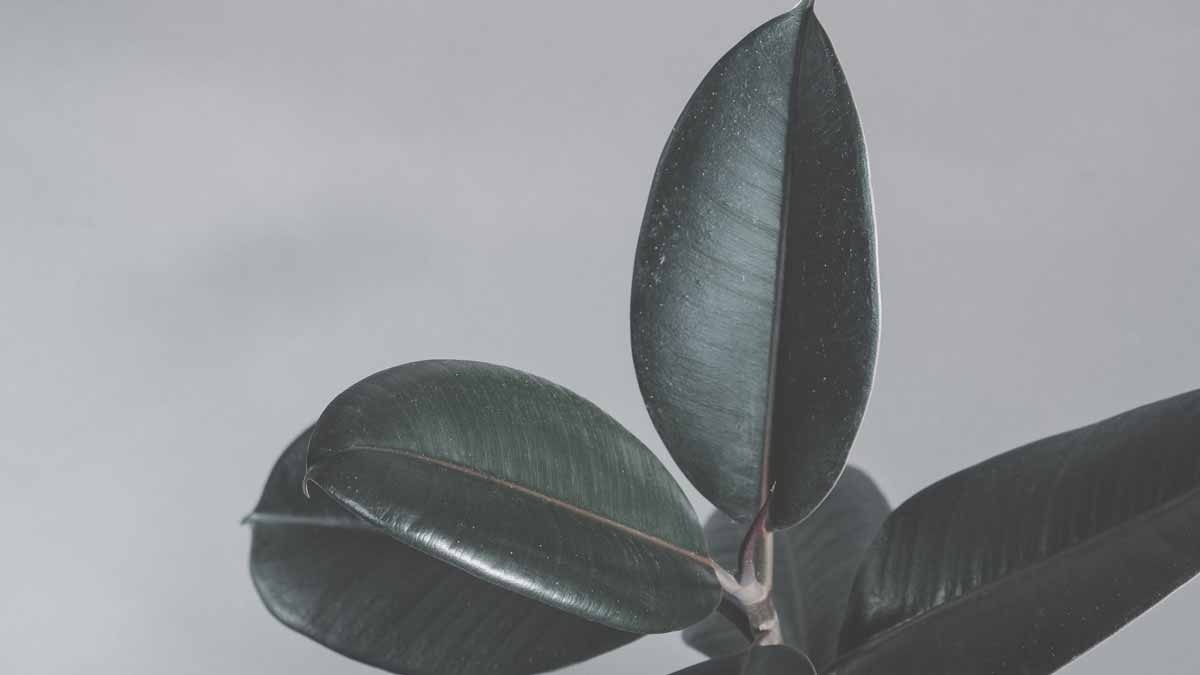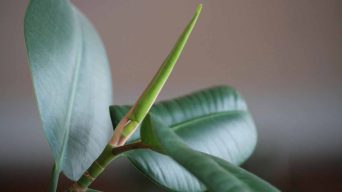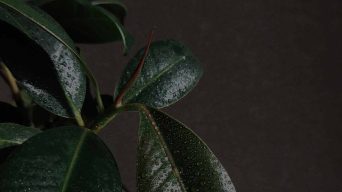Rubber plants (Ficus elastica) are popular houseplants because they are easy to care for and can thrive in various conditions.
However, like all plants, they can sometimes suffer from problems like black spots on their leaves.
There are a few different reasons why this might happen, but don’t worry – in most cases, it is relatively easy to fix.
Keep reading to learn more about the causes of black spots on rubber plant leaves and what you can do about them.
What Causes Black Spots on Rubber Plant Leaves and How Can You Fix It?
When it comes to black spots on rubber plant leaves, a few different things might be happening.
The most common causes of black spots on rubber plant leaves are overwatering, fungal diseases, and pests.
Most of these problems are relatively easy to fix, but it is essential to identify the issue correctly so that you can treat it effectively.
Here are some of the most common causes and how to deal with them:
1. Overwatering
One of the most common reasons for black spots on rubber plant leaves is overwatering.
Overwatering occurs for several reasons, but the most common cause is simply giving plants too much water.
This can happen if a gardener is not familiar with the needs of their plants or if they are watering on a schedule rather than based on the needs of the plants.
Another common cause of overwatering is leaving plants in standing water.
This can happen if a houseplant pot does not have adequate drainage or if the plant is placed in a saucer or dish without holes.
When water saturates the soil and cannot drain away, it creates an environment perfect for fungal growth.
There are a few reasons why overwatering can cause black spots on a rubber tree plant.
Too much water can reduce the amount of oxygen that the roots receive.
This can lead to root rot, which can cause the leaves to turn yellow and eventually black.
Root rot is a severe problem that can kill your plant.
Overwatering can also encourage fungi growth, which can cause black spots on the leaves.
Fungi thrive in moist, warm conditions. If the leaves are constantly wet, they are more likely to develop black spots.
In addition, extended periods of wet conditions can make rubber plants more susceptible to pests and diseases.
How To Fix It
The best way to fix an overwatered rubber plant is to allow the soil to dry out completely between waterings.
If you are unsure how often to water your plants, check the soil before watering.
If the top inch of soil is dry, it is time to water.
It is also essential to ensure that your rubber plant has adequate drainage.
Make sure the pot has drainage holes, and you are not leaving the plant in standing water.
You may also want to consider using a potting mix that drains well, such as cactus mix or a mix containing perlite or vermiculite.
If you think that your rubber plant has root rot, it is best to remove it from the pot and inspect the roots.
If the roots are black and mushy, they are probably rotted.
You can try to save the plant by trimming away the dead roots and replanting it in fresh, dry soil.
However, it is often best to start with a new plant.
2. Fungal Diseases
Fungal diseases are another common cause of black spots on rubber plant leaves.
Different fungi can attack rubber plants and often thrive in warm, moist conditions.
Some of the most common fungal diseases that cause black spots include black spot, anthracnose, leaf spot, and sooty mold.
Black Spot Fungus
Black spot (Diplocarpon rosae) is a common fungal disease affecting many plants, including rubber plants.
The fungus that causes black spot thrives in warm, humid conditions.
It produces spores that are spread by wind and rain.
The spores land on the plant’s leaves and stem, where they germinate and start to grow.
As the fungus grows, it produces black spots on the leaves.
The spots are usually circular and may be surrounded by a yellow halo.
The fungus can also cause the leaves to turn yellow and drop off.
Anthracnose
Anthracnose is another common fungal disease that affects rubber plants.
It is caused by a group of fungi closely related to the fungi that cause black spot.
Anthracnose often affects plants that are stressed or weakened.
The fungus primarily attacks the leaves but can also affect the stems and flowers.
Symptoms of anthracnose include black or brown spots on the leaves, leaf drop, and stunted growth.
Leaf Spot
Leaf spot is a fungal disease that affects a wide range of plants, including rubber plants.
Various fungi cause it, and it often thrives in wet, humid conditions.
Symptoms of leaf spot include small black or brown spots on the leaves.
A yellow halo may surround the spots, and they can eventually merge to form large patches.
The fungus can also cause the leaves to turn yellow and drop off.
Sooty Mold
Sooty mold is a fungus that often grows on the leaves of plants infested with aphids or scale insects.
The insects secrete a sticky substance called honeydew, which the fungus uses as food.
As the fungus grows, it produces a black, sooty mold covering the leaves.
Sooty mold does not directly damage the plant but can cause the leaves to turn yellow and drop off.
In addition, it can interfere with the plant’s ability to photosynthesize.
How To Treat Fungal Diseases
Fungal diseases can be challenging to treat, as they often re-emerge after appearing to be gone.
It is essential to be diligent in preventing and treating these diseases, as they can cause severe damage to your rubber plant.
The first step in preventing fungal disease is to ensure that your rubber plant has plenty of ventilation.
Fungi thrive in moist environments, so it is essential to keep the leaves of your rubber plant dry.
You can also reduce the chances of fungal disease by avoiding overhead watering and by watering the soil, not the leaves.
It’s also essential to choose a well-draining potting mix and avoid overwatering.
In addition, make sure to clean up any fallen leaves or other debris from around your rubber plant, as this can provide a breeding ground for fungi.
If your indoor plant does develop a fungal disease, the first step is to remove any affected leaves.
You should then disinfect all of your rubber plant’s pots and tools.
Next, treat the plant with a fungicide, following the manufacturer’s instructions carefully.
You can use a natural fungicide, such as neem oil or a chemical fungicide.
Once you have treated the plant, monitor it closely for any new symptoms.
You can often successfully treat fungal diseases in rubber plants with diligent care and treatment.
3. Bacterial Infection
Bacterial infections are another common type of plant disease.
They are caused by bacteria that enter the plant through wounds or natural openings.
Once inside the plant, the bacteria multiply and cause tissue damage.
Some of the most common bacterial diseases that cause black spots on rubber plants include:
Leaf Spot
Bacterial leaf spot is a type of plant disease that can affect many plants, including the rubber plant.
The disease is caused by bacteria that enter the plant through wounds or natural openings.
The bacteria then multiply, causing damage to the plant tissue.
Symptoms of the bacterial leaf spot disease include dark spots on the leaves, wilting, and leaf drop.
The spots can range in size from small dots to large patches and often have a yellow halo.
The disease can cause extensive damage to the plant, especially if not treated quickly.
Bacterial Blight
Bacterial blight is a disease that can affect various plants, including the rubber plant.
The disease is caused by a bacterium called Pseudomonas syringae pv. syringae, which infects the plant through wounds in the leaves or stems.
Symptoms of bacterial blight include brown or black spots on the leaves, wilting, and premature leaf drop.
The disease can spread rapidly in warm, humid conditions and can be difficult to control once it takes hold.
How To Treat Bacterial Diseases
If you suspect your rubber plant has a bacterial infection, it is vital to take action quickly.
Bacterial diseases can spread rapidly and cause extensive damage to the plant.
The best way to treat a bacterial disease is with a combination of water, light, and air.
Water the plant deeply, making sure to wet the leaves and stems.
Then, place the plant in a bright location where it will get plenty of direct sunlight.
Finally, ensure the plant has good air circulation by opening a window or using a fan.
If the disease is severe, you can use a copper-based fungicide to help control it.
4. Viral Infection
Viral infections are another plant disease that can cause black spots on rubber plants.
These diseases are caused by viruses transmitted to the plant by insects, such as aphids or whiteflies.
The viruses multiply inside the plant cells, causing damage to the tissue.
Symptoms of viral infections include black spots on the leaves, deformities, and stunted growth.
The viruses can also cause the plant to produce fewer and smaller leaves.
How To Treat Viral Infections
There is no cure for a viral infection, so the best way to deal with it is to prevent it from happening in the first place.
You can do this by keeping your rubber plant healthy and stressed-free.
Make sure to water the plant regularly and fertilize it as needed.
You should also regularly check the plant for insects and remove any that you find.
If your plant becomes infected with a virus, you can try to control it by removing infected leaves and destroying them.
You should also disinfect any tools that you use on the plant.
In most cases, however, it is best to throw away the plant and start with a new one.
5. Pests
Pests are another common cause of black spots on rubber plants.
The most common pests that affect rubber plants include aphids, scale insects, whiteflies, and mealybugs.
Aphids
Aphids are small, pear-shaped insects that can be found in various colors, including green, black, and pink.
They are generally found in large groups on the undersides of leaves, feeding on the plant’s sap.
Aphids typically reproduce rapidly and can quickly overwhelm a rubber plant.
Aphids secrete a sticky substance called honeydew, which can attract other pests and cause sooty mold to grow on the plant.
In addition, aphids can transmit viral diseases from one plant to another.
How To Get Rid of Aphids
The best way to get rid of aphids is to introduce natural predators, such as ladybugs, into your garden.
You can also spray the plant with water to remove the aphids.
You can use insecticidal soap or neem oil if the infestation is severe.
These are natural and effective ways to eliminate aphids without harming your plant.
Scale Insects
Scale insects are tiny, wingless pests often mistaken for bumps or growths on the plant.
They are usually found on the undersides of leaves and can be either immobile or mobile.
Mobile scale insects will crawl from one plant to another, while immobile scale insects will remain attached to the same plant their entire lives.
They can be pretty challenging to control once they become established on a plant.
These pests attach themselves to the plant leaves and feed on the sap, causing the rubber plant leaves to curl, turn yellow, and eventually drop off.
Scale insects can also introduce diseases to the plant, which can further damage its health.
How To Get Rid of Scale Insects
If you suspect your rubber plant has scale, it’s important to take action immediately.
The first step is to isolate the affected plant from any healthy plants.
This will help to prevent the spread of the infestation.
Next, gently wipe the plant leaves with a soft cloth or cotton swab dipped in rubbing alcohol.
This will kill any scale that is present on the surface of the leaves
Another option is to mix water and dish soap and use it to spray the plant.
The dish soap will break down the protective coating the scale insects use to keep from dehydrating, and they will eventually die.
You can also try using horticultural oil, which smothers the insects and prevents them from being able to breathe.
Whichever method you choose, monitor the rubber plant closely and remove any dead insects, so they don’t attract other pests.
Whiteflies
Whiteflies are small, winged insects often found in large numbers on the undersides of leaves.
They feed on the sap of plants and can cause the leaves to turn yellow and eventually drop off.
In addition, whiteflies secrete a sticky substance called honeydew, which can attract other pests and cause sooty mold to grow on the plant.
Whiteflies can also transmit viral diseases from one plant to another.
How To Get Rid of Whiteflies
The best way to get rid of whiteflies is to introduce their natural predators, such as ladybugs, into your garden.
You can also spray the plant with water to remove the whiteflies.
You can use insecticidal soap or neem oil if the infestation is severe.
These are natural and effective ways to eliminate whiteflies without harming your plant.
Mealybugs
Mealybugs are small, wingless insects covered in a mealy, wax-like substance.
They vary in color but are often white or light gray.
Mealybugs are often found on rubber plants, as well as a variety of other indoor and outdoor plants.
These pests feed on plant sap, which can cause leaves to yellow and wilt.
In addition, mealybugs excrete a sticky substance called honeydew, which can attract other pests and cause sooty mold to grow on the plant.
Mealybugs can also transmit viral diseases from one plant to another.
How To Get Rid of Mealybugs
If you suspect that your plant has mealybugs, you can do a few things to get rid of them.
First, isolate the affected plant from your other houseplants to prevent the mealybugs from spreading.
Next, gently wipe the bugs off the plant with a cotton swab dipped in rubbing alcohol.
You can also try spraying the plant with a mixture of water and dish soap.
For stubborn infestations, you can use insecticidal soap or neem oil.
Both of these are effective at killing mealybugs without harming your plant.
How To Prevent Black Spots on Rubber Plant Leaves
The best way to prevent black spots on rubber plant leaves is to keep your plant healthy and free of pests.
Here are a few tips to help you do this:
- Water your plant regularly and evenly, allowing the soil to dry out slightly between waterings
- Use a well-draining pot or planter to prevent root rot
- Keep your plant in a well-ventilated area
- Provide your plant with bright indirect light
- Fertilize your plant monthly during the growing season
- Prune away any dead or diseased leaves as soon as you see them
- Regularly check your plant for pests and treat them immediately if found
These tips will help you keep your rubber plant healthy and free of black spots.
Final Thoughts
Black spots on rubber plant leaves can be caused by various things, including pests, disease, and environmental stressors.
If you suspect your Ficus elastica has black spots, it’s crucial to identify the cause so you can treat it appropriately.
Most black spot problems can be solved with patience and care.
Following the tips in this article, you can prevent black spots on rubber plant leaves and keep your plant looking its best.







